Best tent to buy in 2025 to get closer to nature
We rank the best tents, from simple 3- and 4-person shelters to luxurious tents for the whole family

Pat Kinsella

Are you on the hunt for the best tent for your camping adventure? We're here to help. A tent can easily make or break a camping trip, so before you invest, take a little time to choose carefully.
There is a vast array of options on the market, ranging from surprisingly cheap to astonishingly expensive and teeny-tiny and ultra-packable to downright palatial.
Our guide includes a wide range of options at price points to suit everyone; however, we'll focus more on family and casual group trip tents here. For specialised adventuring options, head to our best backpacking tent or the best pop-up tents guide instead.
Our current favourite family tent is the Quechua Air Seconds 5.2 Fresh & Black. It's spacious, has blackout rooms, and pops up in minutes despite its larger size. For something more affordable, Vango's Classic Instant 300 is the one to get. If you're new to camping and don't need a huge tent, the Sea to Summit Ikos TR 3 might be your best option.
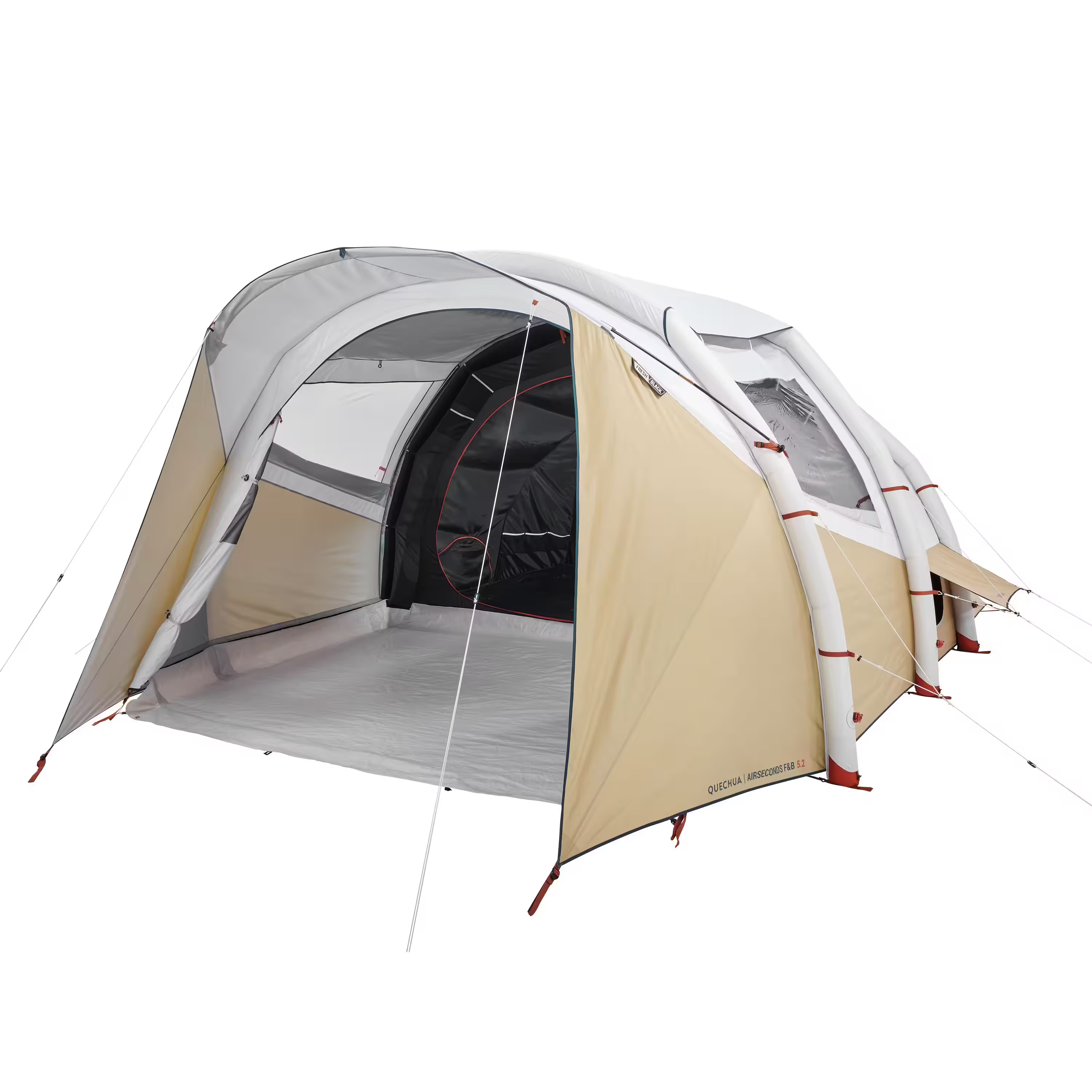
The Decathlon Quechua Air Seconds 5.2 Fresh & Black is an exceptional two-season family tent, thanks to its spacious design, easy setup, and innovative blackout bedrooms. Despite its large size, it's user-friendly and offers excellent ventilation. Highly recommended for family camping.

Vango's Classic Instant 300 offers quick setup, spacious accommodation for three people, and dual doors with porches for added convenience. While it may experience minor condensation and has single-zip doors, its ease of use and affordability make it ideal for festivals and casual camping.

The Ikos TR 3 from Sea to Summit is a spacious, high-quality tent designed for two campers seeking comfort and ease of use. Its innovative Tension Ridge design provides extra headroom and ventilation, enhancing the camping experience. While slightly heavy for lightweight backpacking, it's ideal for car camping and casual adventures.
Best tents to buy right now
Best overall


Specifications
Reasons to buy
Reasons to avoid
If you’re in the market for a large family tent that’s a breeze to pitch, the Quechua Air Seconds 5.2 Fresh & Black is your best bet. This tent stands out for its effortless setup, requiring just 17 minutes with the help of a quality hand pump (sold separately). Its inflatable air beams and superior design make assembly a cinch, even for beginners.
The tent boasts a spacious 31 square meters of interior living space, featuring two blackout bedrooms and a large lounging area. The blackout feature ensures a good night’s sleep by keeping the rooms cooler and darker. The tent's light-coloured exterior reflects sunlight, keeping it cooler during the day.
Designed with high-quality materials, the Air Seconds 5.2 can withstand harsh weather, including heavy rain and strong winds, thanks to its robust construction and well-thought-out design. Ventilation is top-notch, with large mesh openings and adjustable vents, ensuring a comfortable interior climate.
With thoughtful details like ample storage pockets, a durable groundsheet, and an integral clothesline, this tent is perfect for family camping trips. While it’s not ideal for long treks due to its 22kg weight, it’s perfect for car camping and promises a comfortable, hassle-free camping experience.
Read our full Decathlon Quechua Air Seconds 5.2 Fresh & Black review.
Also consider: the Outwell Pinedale 6PA tent offers ample living space, excellent ventilation, and great value for money. Ideal for summer camping, it’s easy to pitch and perfect for families, providing a spacious, airy living area and cosy bedrooms.
Best budget

Specifications
Reasons to buy
Reasons to avoid
One of the best festival tents (certainly one of the most affrodable), Vango Classic Instant 300 offers rapid setup and takedown, making it ideal for events and casual camping. Its spacious interior comfortably accommodates up to three people, with ample headroom enhancing comfort.
Dual doors and porches provide convenient access and storage, while integrated doormats help keep the interior clean. The tent's design ensures stability, though the flysheet's proximity to the inner tent can lead to condensation issues.
Additionally, the single-zip main doors may become cumbersome over time. Despite these minor drawbacks, its affordability and user-friendly features make it a top choice for festival-goers seeking hassle-free shelter.
Read our full Vango Classic Instant 300 review.
Best beginner-friendly

Specifications
Reasons to buy
Reasons to avoid
In 2023, Sea to Summit added to their range of adventurous camping equipment with two tents aimed at car campers and beginner backpackers. These models are simply new takes on the ever-popular cross-pole dome tent design – the ‘TR’ in the tents’ name stands for ‘Tension Ridge’ – with an added third inverted pole that offers extra head height and breathability to the final structure.
Part of this new range is the Sea to Summit Ikos TR3, which ticks lots of boxes – it's easy to pitch and use, very comfortable to sleep in, is weatherproof and bugproof and isn't prohibitively bulky when you're on the go. It's a pity it's a shade too heavy to be a true backpacking tent, but if you already own a small featherweight backpacking tent and want something roomier to share with a buddy on more relaxed camps, this would be an excellent choice.
Read our full Sea to Summit Ikos TR 3 review.
Best fast-pitch
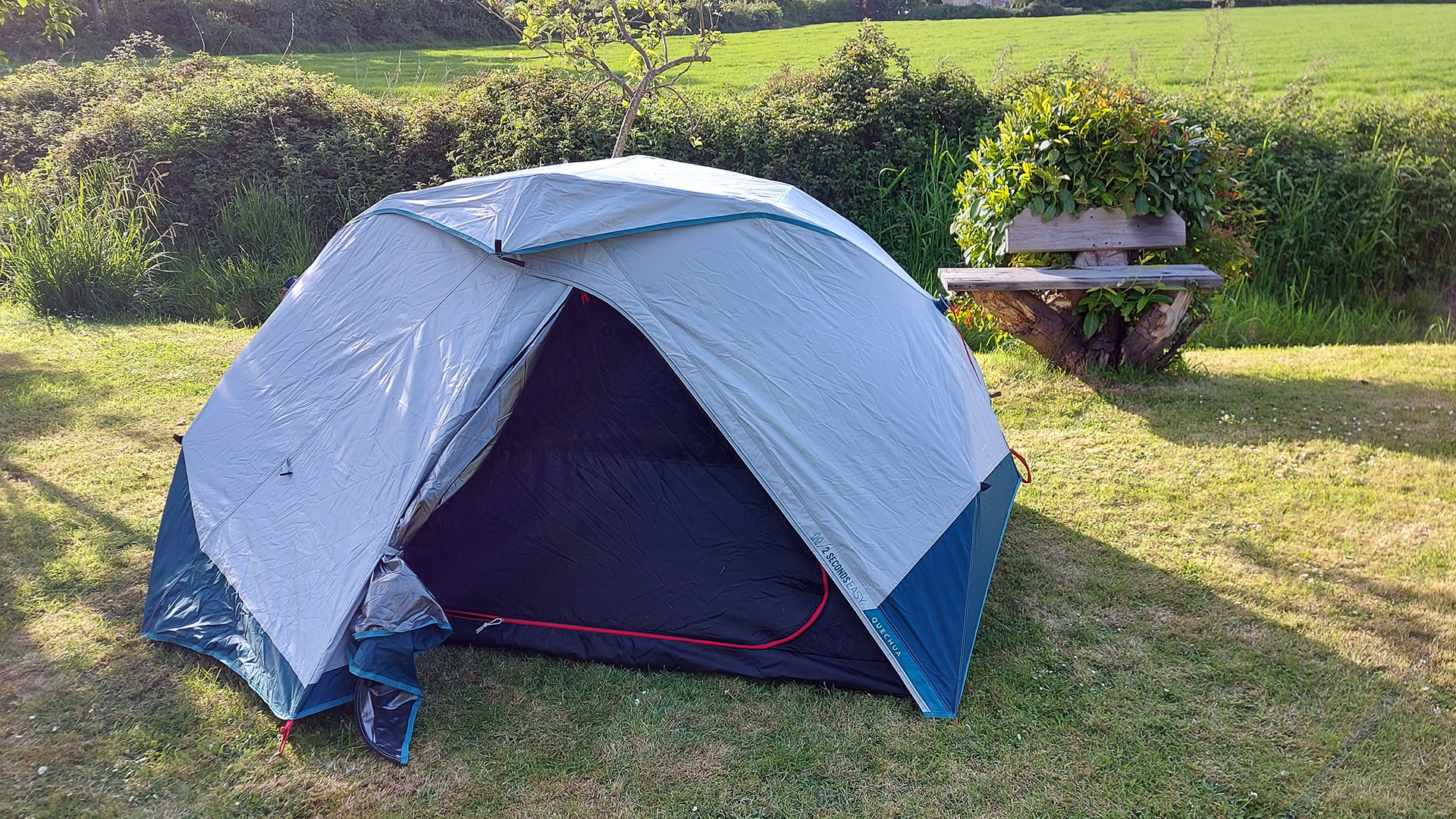
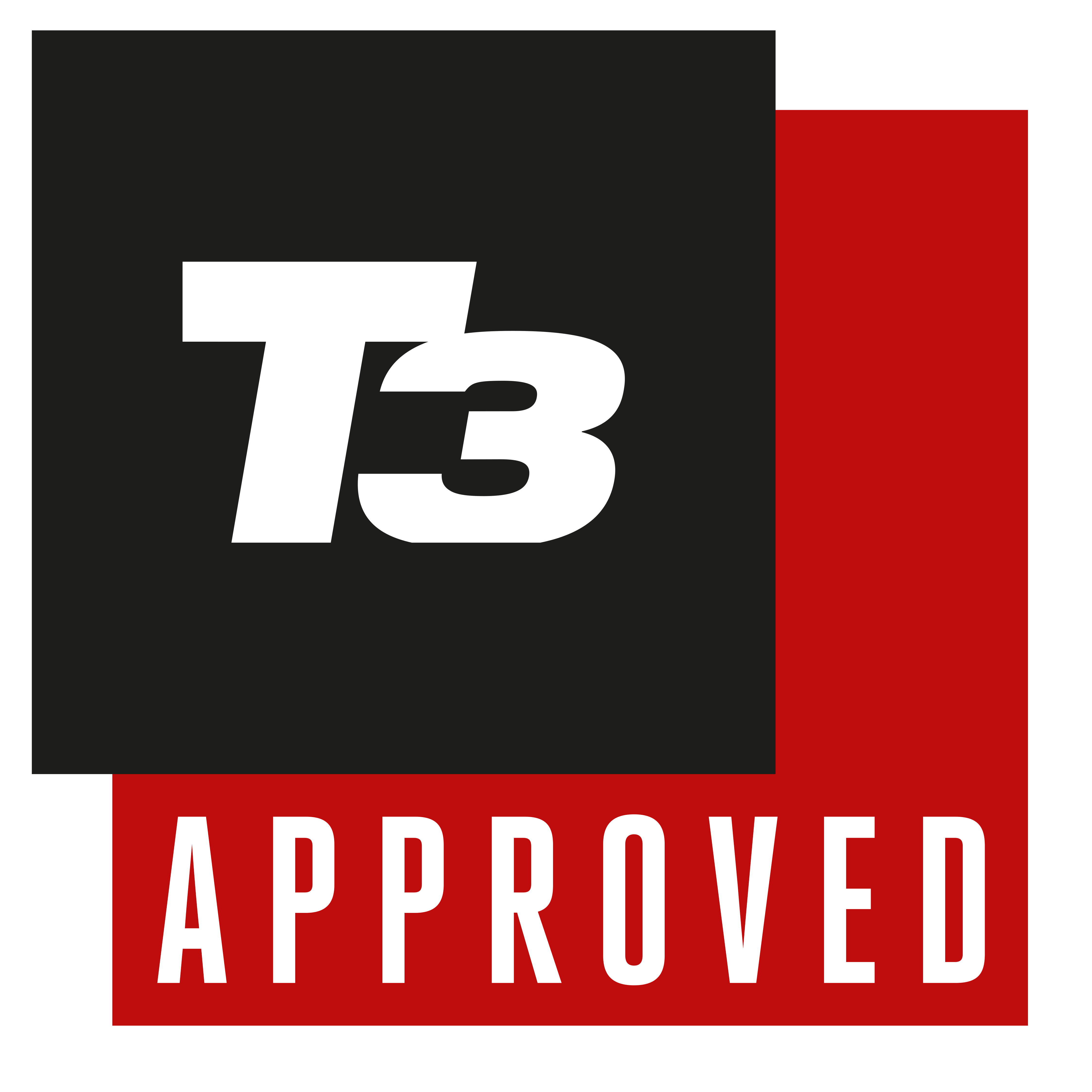
Specifications
Reasons to buy
Reasons to avoid
If you're looking for a quick-pitch option, the Quechua 2 Seconds Easy Fresh & Black (2-person) is perhaps the most faff-free tent we've tested. It sits right at the top of our pop-up tent guide (linked in the intro), and with good reason. Pitching is a simple matter of pegging out the four corners, then pulling on two red drawcords until they click into place, and thanks to some kind of interior witchcraft, you're pretty much done.
If you want, you can add two more pegs to create little porches on either side of the sleeping compartment (great for keeping muddy boots away from your sleeping bag), and if it's windy, you can also pop on some guy ropes for security. There are two layers, which means no morning condensation issues, but it's all connected together, so you can easily put it up in the rain without the interior getting wet. Blackout fabric means you don't have to wake up with the dawn, and it's great value too.
Read our full Quechua 2 Seconds Easy Fresh & Black (2-person) review.
Best for glamping


Specifications
Reasons to buy
Reasons to avoid
Looking for something a little more spacious than the average backpacking tent but don't want to go all-in on an extravagant glamping option? The unusual-looking Robens Yukon Shelter might just hit that sweet spot for you. Inspired by simple wood refuges found around the Scandinavian countryside, its boxy design stands out from the usual glamping tents you might come across, and it gives you plenty of room with standing height in part of the bedroom and a decent-sized porch.
It's well-made with plenty of attention to detail, including reflective guy lines, insect-repelling mesh screens and solid toggles for tying up the main door. Putting it up for the first time could be a challenge, thanks to frankly inadequate instructions (we ended up watching an online video to figure it out). Once it's up, it's a roomy and breathable shelter that's ideal for summer camping holidays or for putting up in your back garden as a sun shade or playhouse.
Read our full Robens Yukon Shelter review.
Best inflatable
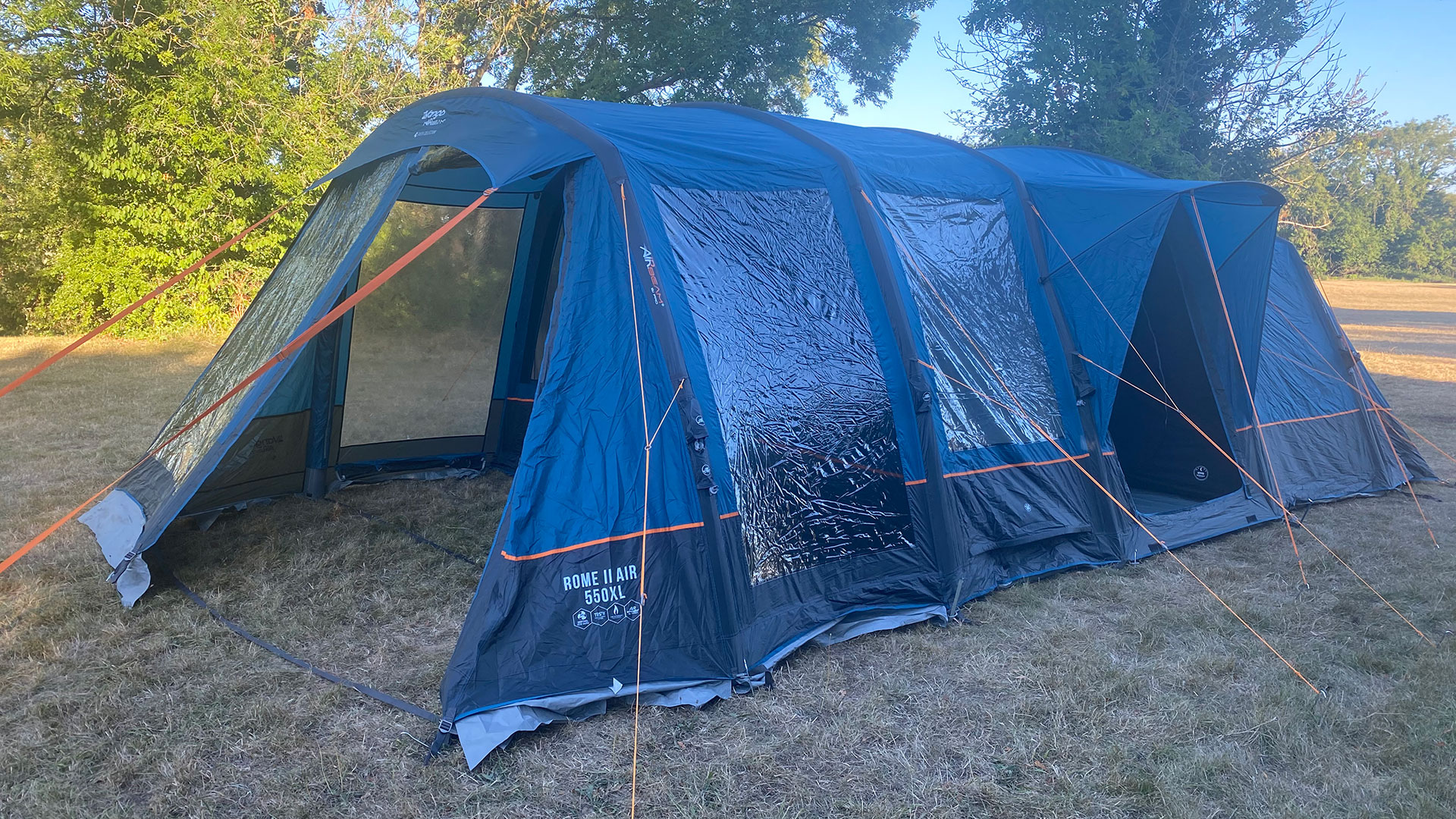

Specifications
Reasons to buy
Reasons to avoid
As a low-fuss tent suitable for a family of four's summer camping holiday, Vango Rome II Air 550XL is a tough one to beat. Just the right size for two adults and a pair of kids, this air tent has plenty of living space, it's easy to pitch thanks to its inflatable poles, and as it's made of recycled fabrics, it's an eco-friendly option, too.
Unlike most large inflatable family tents, this Vango genuinely is quite easy to pitch; once you've found your spot, it's a matter of pegging out the corners, inflating the poles with the included pump, and then pegging the main and side tent into place. Vango reckons it takes 12 minutes; expect it to take a bit longer, especially on your first try.
There's lots of room inside, including two blackout bedrooms with standing room, plus a well-sized living area and porch with room for a dining table and loungers. However, we found that the storage space was just a little on the small side; don't count on being able to use it as a spare bedroom.
Read our full Vango Rome II Air 550XL review.
Best premium
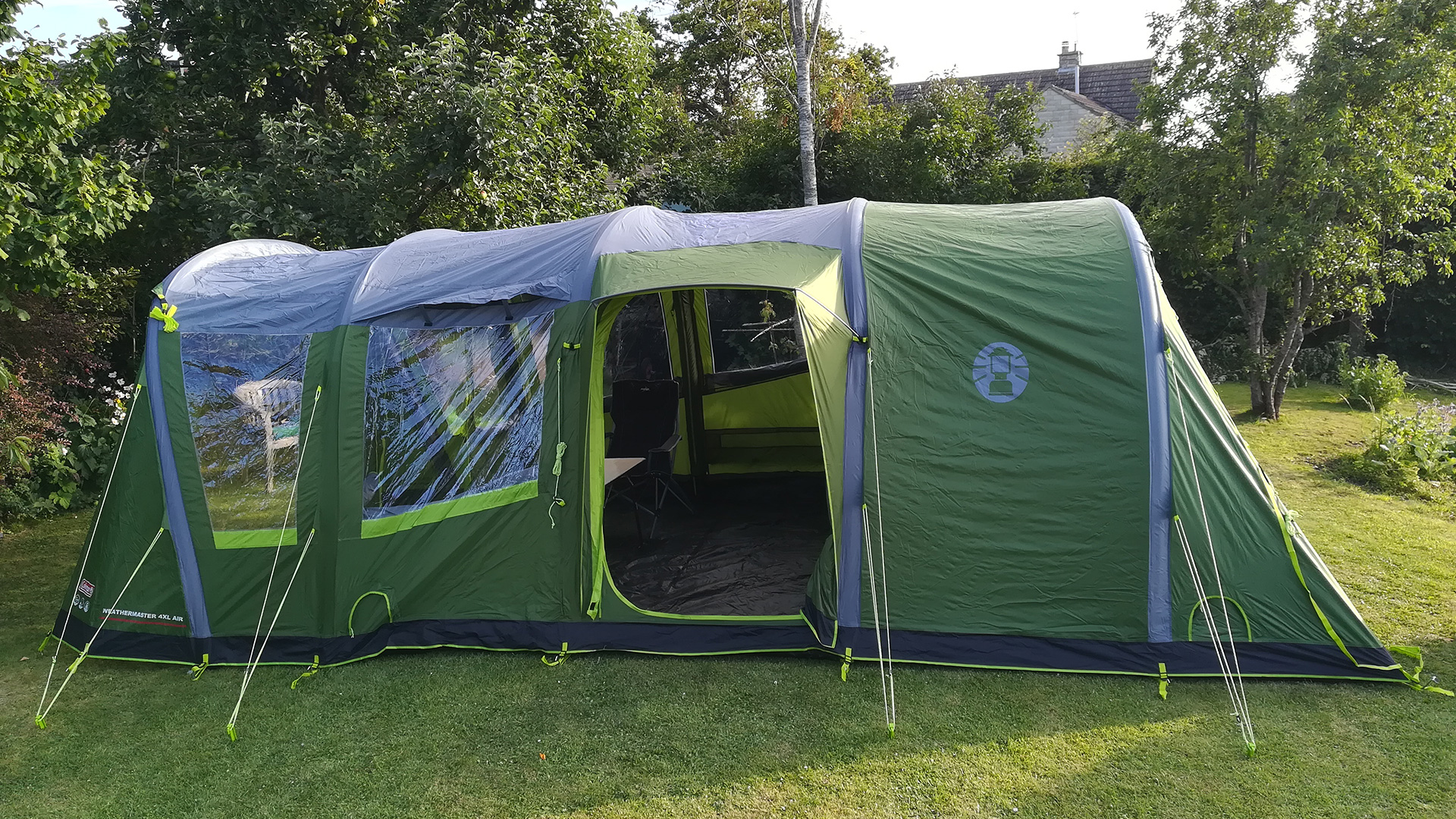

Specifications
Reasons to buy
Reasons to avoid
The Coleman Weathermaster Air 4XL is an outstanding family tent. The living space is roomy, light and airy, with a spacious porch area and mesh door layers you can close up at night if you want airflow without the bugs. The all-important blackout bedrooms are very effective: not only do they block out the evening and early morning light, but they also help regulate the temperature inside the sleeping compartment.
An all-in-one design and air poles mean this tent is extremely quick and easy to put up, so you can get on with your holiday as quickly as possible (let's face it, wrangling with a tricky tent after hours in the car can be fraught at the best of times, let alone with grumpy kids in tow). At a push, one person could even do it on their own – let's say if the younger family members aren't cooperating at the time. In short, the best family tent for comfortable and relaxed family camping, whatever the weather's doing.
Read our full Coleman Weathermaster Air review.
Best eco-friendly


Specifications
Reasons to buy
Reasons to avoid
If you've ever had trouble finding your tent at a festival, that's not a problem you're likely to run into with the Decathlon Forclaz Trekking Dome Tent. It comes in one colour option – a dazzling white – which should make it easy to find at any time, although the downside is that after a few outings, it's likely to have settled into a grubby grey with hints of grass stains.
There's a good reason for this eye-catching look: it avoids the use of dyes, which reduces CO2 emissions and avoids water pollution in manufacturing, making it a much more eco-friendly tent. It's easy to put up and has plenty of room for two people, as well as two porches for keeping your gear dry and four pockets for storing gear; it also packs away nicely. We found it to be good and waterproof even in heavy rain, and its low profile means it'll stand up to high winds too.
Read our full Decathlon Forclaz Trekking Dome Tent – Minimal Editions review.
To save on the cost, make sure you check our Decathlon discount codes.
Best roof tent
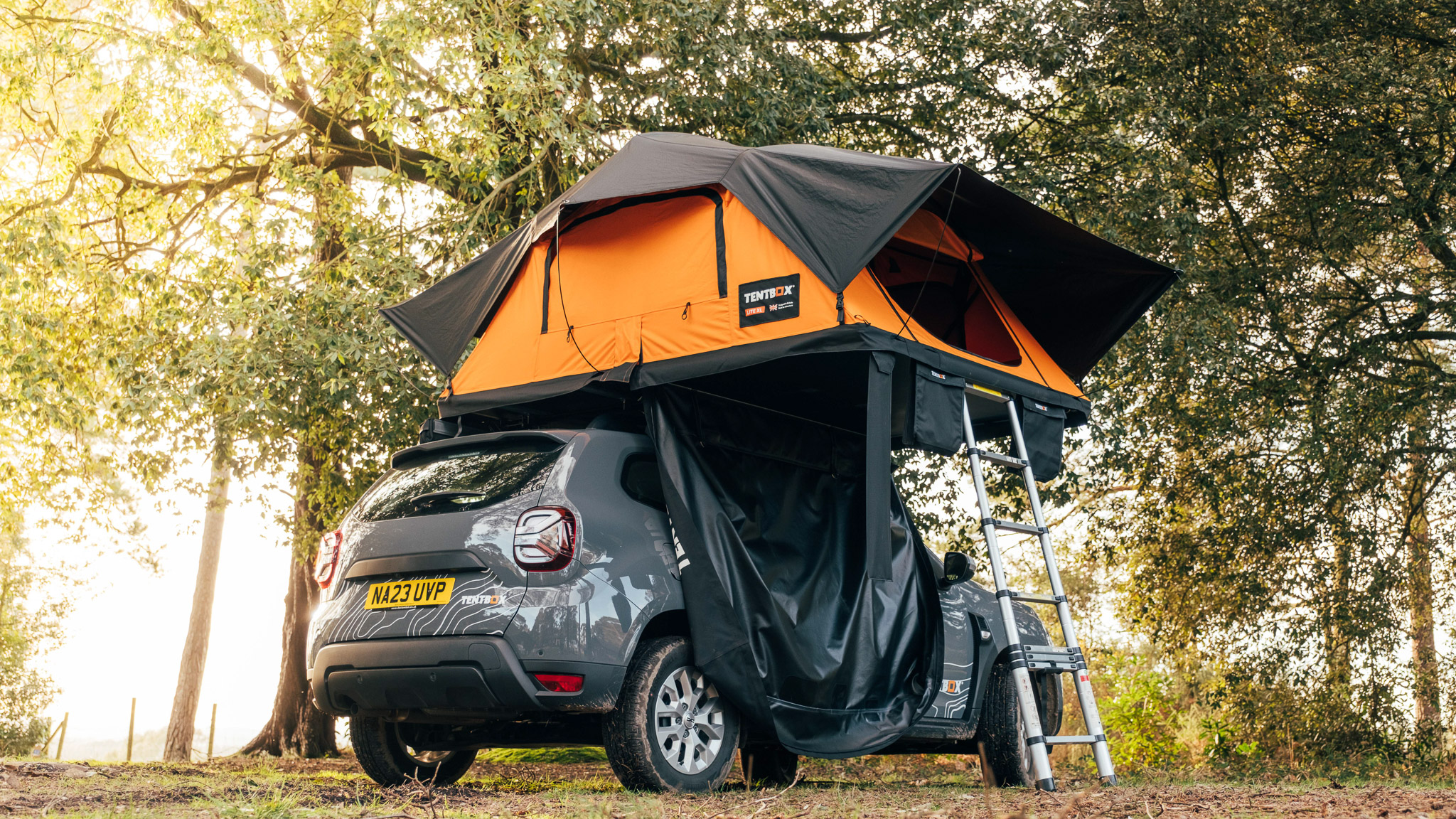
Specifications
Reasons to buy
Reasons to avoid
The TentBox Lite XL offers an innovative car-camping solution with spaciousness and durability. Compared to other tents, it requires more effort to set up, but its generous interior space justifies the extra time. With room for up to four adults, it's ideal for families or couples seeking a lofty basecamp.
While the initial cost is substantial, it provides a faster setup than traditional tents and offers protection from water and wind. The tent's design features durable materials like 600D polyester PVC and a lightweight aluminium frame, ensuring stability and weather resistance.
Performance-wise, it withstands various weather conditions, providing comfort and ample room for sleeping and storage. Optional accessories like the KitchenBox enhance camping convenience, albeit at an additional cost. Overall, the TentBox Lite XL offers a convenient and spacious rooftop camping experience, perfect for adventurous families or couples seeking comfort and versatility on the road.
Read our full TentBox Lite XL review.
How to choose the best tent for you
Choosing the perfect tent for your outdoor adventures is a bit like picking the ultimate camping buddy – you want someone who fits just right and can handle whatever Mother Nature throws your way.
First up, think about your camping crew size. Are you rolling solo or bringing the whole squad? Remember, it's not just about bodies but also gear space – nobody likes a cramped tent.
Next, consider your camping style. Are you cruising in with your car, setting up shop next to it, and calling it a day? Or are you planning a backpacking odyssey where every ounce counts? Your tent choice will definitely reflect your adventure vibe.
Then, there's the weather to think about. Will you be battling rain, wind, or blazing sun? Look for a tent that can handle the elements like a pro – nobody wants a soggy sleep or a windblown shelter.
Setup should be a breeze, not a battle. Opt for a tent that's as easy to pitch as a beach umbrella – because ain't nobody got time for wrestling with tent poles when you could be roasting marshmallows.
Features are the cherry on top of your tent sundae. Think room dividers for a little privacy, gear vestibules for stashing your stuff, and windows for catching those scenic views.
Durability is key – you want a tent that can take a beating and still come out swinging. Look for tough materials that can handle rough-and-tumble camping adventures.
Last but not least, don't forget your budget. You don't need to break the bank to find a great tent, but remember, you get what you pay for in the camping world.
With these tips in mind, you'll be snuggled up in your perfect tent in no time, ready to conquer the great outdoors with style and comfort. Happy camping!
How we test the best tents
Testing a tent is like trying on a pair of walking shoes – you've got to make sure it fits just right! First off, we give it a good visual inspection. We check for any tears, loose seams, or broken zippers. Then, it's time to set it up. We pay attention to how easy or complicated it is to assemble. Nobody wants to wrestle with a tent in the middle of a storm!
Once it's up, we hop inside and give it a shake. We channel our inner wild bear and see if it holds up to a little roughhousing. We also assess how spacious it feels. Can you stretch out comfortably or are you rubbing elbows with your camping buddy?
Then there is ventilation – nobody likes waking up in a sweat lodge! Finally, we spend a few nights in it to ensure the tent is suitable as an outdoor shelter. If it passes all these tests with flying colours, we add them to our tent guide!
FAQ
What are the different types of tents?
Modern tents for camping, backpacking, hiking and general outdoor living come in a range of shapes and sizes. The most popular ones are basic ridge tents, dome tents, geodesic and semi-geodesic, inflatable tents, bell tents, teepees and tunnel tents.
Some of the major brands you’ll come across in your journey to find the best tent for you include Big Agnes, Vango, Coleman, MSR, Terra Nova, Outwell, Decathlon, Hilleberg and The North Face. There are lots of newcomers entering the (muddy) field, too, with innovative designs coming from brands such as Tentsile, with its sublime floating tree tents, and Cinch, with its nifty pop-up modular tent.
What's the best HH rating for a tent?
HH stands for Hydrostatic Head, and it's a measure of how waterproof a fabric is. It's given in millimetres; the higher the number, the more waterproof. You should look for a bare minimum HH of 1500mm for a tent. 2000 and above will be fine for even the worst UK weather, and 5000 and above is getting into specialist territory. Here's more on what a HH rating is.
How can you tell if a tent is good quality?
To assess a tent's quality, examine its materials, construction, and weather resistance. Look for durable, waterproof fabrics, reinforced seams, and sturdy zippers. Consider design features like a bathtub-style floor and ample ventilation. Easy setup with colour-coded poles is essential. Research brand reputation and read reviews for real-world feedback. A quality tent should withstand various weather conditions and offer reliability and durability for outdoor adventures.
Get all the latest news, reviews, deals and buying guides on gorgeous tech, home and active products from the T3 experts

Matt Kollat is a journalist and content creator who works for T3.com and its magazine counterpart as an Active Editor. His areas of expertise include wearables, drones, fitness equipment, nutrition and outdoor gear. He joined T3 in 2019. His byline appears in several publications, including Techradar and Fit&Well, and more. Matt also collaborated with other content creators (e.g. Garage Gym Reviews) and judged many awards, such as the European Specialist Sports Nutrition Alliance's ESSNawards. When he isn't working out, running or cycling, you'll find him roaming the countryside and trying out new podcasting and content creation equipment.
- Pat KinsellaFreelance outdoor writer